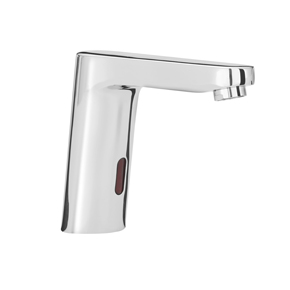
Combating cross contamination in washrooms
The importance of infrared washroom technology in the commercial sector environment cannot be underestimated. Not only can it drastically reduce the risk of cross contamination, aiding infection control, but it can also help to eliminate wastage, leading to significant cost reductions.
Having recently extended its infrared portfolio for commercial customers, Chris Tranter at Bristan talks with ABC+D Magazine on the importance of non-touch technology…
Control of cross-contamination in commercial and public sector buildings is of utmost importance to maintain the health and wellbeing of occupants.

“It is important that all specifiers take advantage of the latest infrared solutions which can help to significantly reduce infection…”
Here, the biggest risk lies in the washroom. Due to their function and being a communal area which is in constant use, washrooms provide a breeding ground for germs and bacteria which can then be transferred from one surface to another.
This can lead to illnesses, some being serious, including salmonella, flu, diarrhoea and impetigo. Notably, in 2006, poor hand hygiene was attributed to the spread of MRSA (methicillin-resistant Staphylococcus aureus) in UK hospitals.
As such, recent years have seen high-risk environments, such as hospitals and schools, come under increased pressure to optimise their infection control regimes and alleviate the risk of cross-contamination.
However, this risk isn’t just limited to the public domain. When it comes to the office environment, for example, it is estimated that workers are likely to spend an incredible 41 hours in the company washroom each year, the equivalent of more than one whole week at work.
Yet one in four admits to not washing their hands every time they visit the washroom, putting the hygiene of their colleagues at risk.
And so, clearly all commercial settings have a duty of care to alleviate this risk by providing a clean and hygienic washroom supported with rigorous infection-control measures.
Fundamentally, it is important to instil behavioural change by encouraging everyone, both building occupants and visitors, to wash their hands regularly with soap and warm water.
Good practice also constitutes routine sterilisation with a focus on cleaning and disinfecting germ-prone surfaces and objects such as countertops, urinals, toilets, door knobs, toilet handles and faucets. However, even with these measures in place, there is still room for bacteria to spread.
This can be avoided by the installation of solutions that offer completely hands-free operation whereby automatic detection eliminates the risk of germs being spread via the hands.
One example is the latest generation of infrared taps. These types of taps use infrared technology to detect human presence and switch on the water flow, delivering the right amount of water when required.
In this way, the non-touch mechanism alleviates the risk of germs spreading, making it suitable for use in all premises seeking to optimise hygiene levels – all while eliminating water waste too.
Another solid recommendation is a urinal infra-red automatic flush. Working in a similar way, the infra-red technology detects human contact and automatically flushes the individual urinal after use, again inhibiting the spread of germs.
Plus, the direct flush removes the need for an auto-flush cistern and associated plumbing used in traditional installations, which flush all urinals intermittently.
There is a major added bonus to using both of these technologies – efficiency. Whereby with traditional setups, taps may be left running – or simply drip, while cisterns may have an unnecessarily high water demand, non-touch technology means water is only used as needed.
This enables commercial providers to significantly minimise mains water use in order to lower their environmental impact and cut water bills. However, the considerations don’t quite end there.
Recently a new infrared soap dispenser specifically created to aid infection control in public sector premises has been introduced.
In a similar vein to water-related infrared products, the dispenser spout incorporates infrared technology to detect human presence and dispense a user-set volume of soap, thus negating the risk of cross-contamination between hands.
In addition, wastage is eliminated, thus further helping with efficiency measures. The risk presented by infection spread in the washroom is a serious one.
We need only look at the stack of prior headlines around infection rates caused by poor hand hygiene in the healthcare sector, to see the tangible health issues presented.
As such, it is important that all specifiers and contractors take a considered approach to washroom specification and take advantage of the latest infrared solutions which can help to significantly reduce infection – all while saving water.
One comment on “Combating cross contamination in washrooms”
Leave a Reply
You must be logged in to post a comment.
Latest news

26th April 2024
Alumasc Skyline and Rainwater package specified at Weston-super-Mare Hospital
A package of products from Alumasc Water Management Solutions (AWMS) has been used for the external refurbishment of the roofline at Weston General Hospital in Weston-Super-Mare.
Posted in Aluminium Products, Articles, Building Industry News, Building Products & Structures, Building Services, Building Systems, Case Studies, Cladding, Drainage Services, Drainage, Guttering, Soffits & Fascias, Fascias, Restoration & Refurbishment, Retrofit & Renovation, Roofs, Walls
26th April 2024
Hush Acoustics optimises fleet operations by securing FORS Gold accreditation
Hush Acoustics has invested in the safety and sustainability of its commercial vehicle fleet by achieving Gold status in the Fleet Operator Recognition Scheme (FORS).
Posted in Acoustics, Noise & Vibration Control, Articles, Building Industry News, Building Products & Structures, Building Regulations & Accreditations, Building Services, Ceilings, Facility Management & Building Services, Floors, Health & Safety, Insulation, Restoration & Refurbishment, Retrofit & Renovation, Site Preparation, Sustainability & Energy Efficiency, Walls, Waste Management & Recycling
26th April 2024
Safeguard Europe: Penetrating damp - how to diagnose the damage
As Safeguard gets ready to deliver another informative session of one of its most popular webinars, the company outlines some of the most common reasons for rain penetration through brickwork.
Posted in Articles, Bricks & Blocks, Building Industry Events, Building Industry News, Building Products & Structures, Building Services, Continuing Professional Development (CPD's), Damp & Waterproofing, Facility Management & Building Services, Information Technology, Posts, Render, Restoration & Refurbishment, Retrofit & Renovation, Seminars, Training, Walls
25th April 2024
ADSA: Competence Initiative Makes Progress
The Joint Competency Initiative (JCI), in which the Automatic Door Suppliers Association (ADSA) is involved, is finalising its first framework for installers within the door, gates and shutter industry.
Posted in Access Control & Door Entry Systems, Architectural Ironmongery, Articles, Building Associations & Institutes, Building Industry Events, Building Industry News, Building Products & Structures, Building Regulations & Accreditations, Building Services, Continuing Professional Development (CPD's), Doors, Facility Management & Building Services, Health & Safety, Innovations & New Products, Publications, Research & Materials Testing, Restoration & Refurbishment, Retrofit & Renovation, Security and Fire Protection, Site Preparation

Such a fantastic article, I actually feel that cross contamination in the work place is something that is not spoken about enough. In a small or large office, I have seen plenty of people that quite frankly, don’t do themselves justice in the hygiene department and there is so many ways that business owners can tackle the problem.
I recently actually had infrared taps installed and water bill has actually been cut a great deal, shocked me if I am honest.
I also had infrared soap dispensers installed (I am a bit of a clean freak) in the office and personally, feel that it has helped a great deal with general cleanliness, plus my staff seem to prefer it, so was worth while
Keep up the great posts!